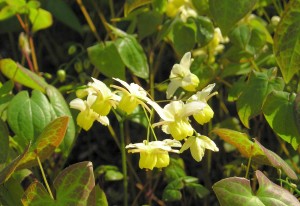When is a barberry not a barberry? When it is a bishop’s hat.
And sometimes that bishop’s hat is also known as barrenwort, fairy wings or even horny goat weed. In all cases, the plant in question is epimedium, a shade-loving, spring bloomer that covers ground in a very appealing way.
When most of us think of the barberry or Berberidaceae family, we think of a vigorous shrub, either wanted or unwanted, with intensely prickly stems. Epimedium, though part of the barberry family, is neither prickly nor a shrub. It is, in fact, a flowering perennial that provides three seasons of interest in exchange for very little effort from the gardener.
It seems quite fitting that I first saw bishop’s hat in the Bishop’s Garden on the grounds of the National Cathedral in Washington, D.C. I was drawn to the elongated, heart-shaped leaves and the small pink flowers, which reminded me less of bishop’s hats and more of tiny columbines, complete long, spur-shaped petals. The mature planting that I saw covered a number of square feet and blanketed the bare earth completely. I saw no weeds at all, which made me wonder if the plants blocked out the weeds, or if the dedicated cadre of volunteer weeders took care of their removal. Either way, I saw the possibilities for epimedium in my own garden. I decided to investigate.
I found that epimedium is not hard to locate through catalog and online sources. The “shade plant” sections of good nurseries and garden centers also stock the plants, especially in the spring. A number of species and hybrids are available.
The most readily available species is Epimedium grandiflorum, or large-flowered epimedium. The plants grow between 12 and 18 inches tall and spread to a maximum width of about 12 inches. The flowers, in white or shades of purplish pink, appear in racemes or sprays, growing on wiry stems that lift them above the leaves. Those leaves may be variegated with reddish coloration in spring. The colors fade to green in summer, but reappear in deeper tones in fall before disappearing for the winter. Popular grandiflorum varieties include ‘White Queen’, ‘Lilafee’, and ‘Purple Pixie’.
Bishop’s hat is so useful in the garden that breeders have gone to work to expand the color range and improve the plants overall. ‘Orange Queen’, for example is a hybrid with apricot flowers and leaves that color up in spring and fall much like those of the grandiflorum varieties. ‘Sulphureum’, as the name suggests, bears yellow flowers and has all the virtues of its parent species, which include grandiflorum. ‘Merlin’s flowers are described as “wine colored”. ‘Wudan Star’ a white-flowered variety of Epimedium stellulatum, features petals that are pointed, rather than spurred, giving each bloom a star-like shape. The flowers are also larger than normal.
When all is said and done, the color range now includes various shades of yellow, orange rose, pink and light purple. The leaves may be smooth or slightly toothed, but most change colors with the season. In warm climates epimedium may be semi-evergreen. By contrast, in my home garden all that remains at winter’s end are the wiry stems. In mid spring, when you least expect it, the leaves burst forth, followed by abundant flowers. They are too small for arrangements, but last a relatively long time in the garden.
Bishop’s hat has many virtues, but among the most notable are a lack of appeal to deer, rabbits and other varmints; high tolerance for shade and clay soil; and ease of division. This means that after a few years, you can dig up an established clump, separate the rhizomes and distribute the resulting pieces around your garden or give them away to friends.
Because the plants flourish in light to medium shade, they provide the one thing that most gardeners covet—color in dark places. The emerging foliage can also help to camouflage the spent leaves of spring bloomers like tulips and daffodils. It is really a wonder that more people do not cover shady ground with bishop’s hat. It beats hauling the bags of mulch that would otherwise do the same job.
If you are looking for a good epimedium selection, try Digging Dog Nursery, which lists 22 different species and varieties. Find them at 31101 Middle Ridge Road, Albion, CA 95410; 707-937-1130; www.diggingdog.com. Print catalog available.
